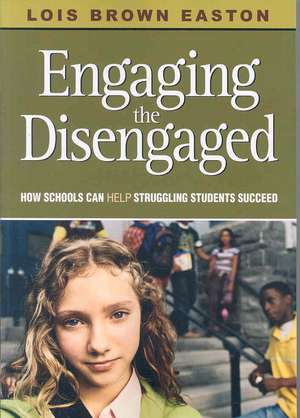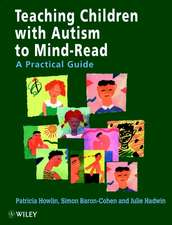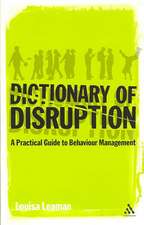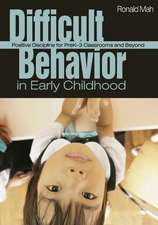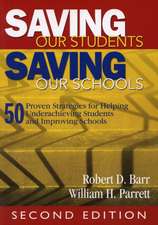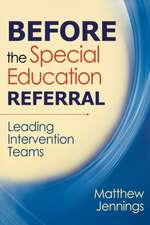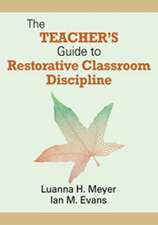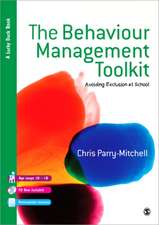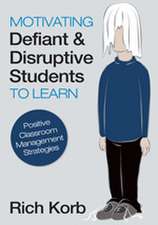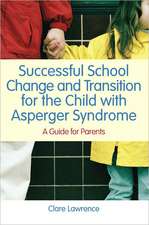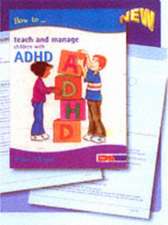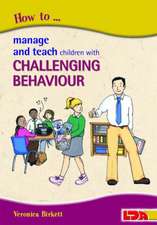Engaging the Disengaged: How Schools Can Help Struggling Students Succeed
Editat de Lois E. Brown Eastonen Limba Engleză Paperback – 3 dec 2007
Preț: 336.75 lei
Nou
Puncte Express: 505
Preț estimativ în valută:
64.45€ • 66.77$ • 53.78£
64.45€ • 66.77$ • 53.78£
Carte tipărită la comandă
Livrare economică 21 martie-04 aprilie
Preluare comenzi: 021 569.72.76
Specificații
ISBN-13: 9781412949996
ISBN-10: 1412949998
Pagini: 304
Dimensiuni: 178 x 254 x 18 mm
Greutate: 0.62 kg
Ediția:1
Editura: SAGE Publications
Colecția Corwin
Locul publicării:Thousand Oaks, United States
ISBN-10: 1412949998
Pagini: 304
Dimensiuni: 178 x 254 x 18 mm
Greutate: 0.62 kg
Ediția:1
Editura: SAGE Publications
Colecția Corwin
Locul publicării:Thousand Oaks, United States
Recenzii
"Principals—particularly secondary principals—should find this book and Easton's earlier work to be all the basic resources required. It is comprehensive and deals with the critical issues of the day."
"An inspiring book! Easton's clear, compelling writing is made more vivid by the wonderful real-life examples."
"The teacher who knows how to re-engage a child in his or her own learning is a treasure indeed, as is the school that supports such a teacher. Easton tells the stories of these teachers in one such school. They are stories from which all teachers—and principals, school boards, parents, and students—can learn."
"Easton's book shares realistic and inspiring examples of the kind of engagement that transforms kids' lives."
“This insightful and invaluable resource is about changing the culture of schools to be more humane for struggling learners. Filled with real examples, it inspires teachers to create an integrated system of support that can make a significant change in their school’s culture to engage developing minds and champion all learners, regardless of socioeconomic factors.”
"Should be required reading for any teacher."
“This is a very practical text strongly anchored in theory. By looking at the ‘so what’ and ‘what now’ sections at the end of each chapter, teachers have an opportunity to practice some of these lessons. Easton presents an excellent analysis of self-directed learners, and looks at constructivist and traditional classrooms as well as project-based and experiential learning.”
"The author defines engagement as what happens when students 'want to learn and keep learning.' She strongly believes that it is central to the purpose of education and can occur for all students when 'challenge and skill are well-matched.' Easton’s book provides a road map for change in school culture, curriculum, and instruction for all grade levels."
"An inspiring book! Easton's clear, compelling writing is made more vivid by the wonderful real-life examples."
"The teacher who knows how to re-engage a child in his or her own learning is a treasure indeed, as is the school that supports such a teacher. Easton tells the stories of these teachers in one such school. They are stories from which all teachers—and principals, school boards, parents, and students—can learn."
"Easton's book shares realistic and inspiring examples of the kind of engagement that transforms kids' lives."
“This insightful and invaluable resource is about changing the culture of schools to be more humane for struggling learners. Filled with real examples, it inspires teachers to create an integrated system of support that can make a significant change in their school’s culture to engage developing minds and champion all learners, regardless of socioeconomic factors.”
"Should be required reading for any teacher."
“This is a very practical text strongly anchored in theory. By looking at the ‘so what’ and ‘what now’ sections at the end of each chapter, teachers have an opportunity to practice some of these lessons. Easton presents an excellent analysis of self-directed learners, and looks at constructivist and traditional classrooms as well as project-based and experiential learning.”
"The author defines engagement as what happens when students 'want to learn and keep learning.' She strongly believes that it is central to the purpose of education and can occur for all students when 'challenge and skill are well-matched.' Easton’s book provides a road map for change in school culture, curriculum, and instruction for all grade levels."
Cuprins
Preface
Introduction
About the Author
Section 1. Improving the Culture for Struggling Students
1. From a Testing to a Learning Culture: "What About Test Scores?"
2. Relationships Are as Important as Content: "What Do You Mean, Build Relationships? My Job Is to Teach History."
3. Intentional Learning Communities Foster Learning: "What's Community Got to Do With Learning?"
4. How Principles Govern a School Better Than Rules: "So, What About Discipline?"
5. A Democratic School Helps Students Learn: "What's Democratic About Schools?"
Section 2. Improving Curriculum, Instruction, and Assessment for Struggling Students
6. Developing Curriculum According to the Right Standards: "What About Standards?"
7. Innovative Instructional Strategies Help Students Learn: "How Do You Get Them to Learn?"
8. Learning From Assessing Learning: "How Do You Know They've Learned?"
Conclusion: The Importance of Looking at the Student as a Whole Person
Resources: Part A. About Eagle Rock School and Professional Development Center
Resources: Part B. Test Score Data From Eagle Rock School and Professional Development Center
References
Index
Introduction
About the Author
Section 1. Improving the Culture for Struggling Students
1. From a Testing to a Learning Culture: "What About Test Scores?"
2. Relationships Are as Important as Content: "What Do You Mean, Build Relationships? My Job Is to Teach History."
3. Intentional Learning Communities Foster Learning: "What's Community Got to Do With Learning?"
4. How Principles Govern a School Better Than Rules: "So, What About Discipline?"
5. A Democratic School Helps Students Learn: "What's Democratic About Schools?"
Section 2. Improving Curriculum, Instruction, and Assessment for Struggling Students
6. Developing Curriculum According to the Right Standards: "What About Standards?"
7. Innovative Instructional Strategies Help Students Learn: "How Do You Get Them to Learn?"
8. Learning From Assessing Learning: "How Do You Know They've Learned?"
Conclusion: The Importance of Looking at the Student as a Whole Person
Resources: Part A. About Eagle Rock School and Professional Development Center
Resources: Part B. Test Score Data From Eagle Rock School and Professional Development Center
References
Index
Descriere
This resource helps teachers motivate struggling students with strategies that harness their interests and creativity, and encourages educators to create positive learning cultures for all students.
